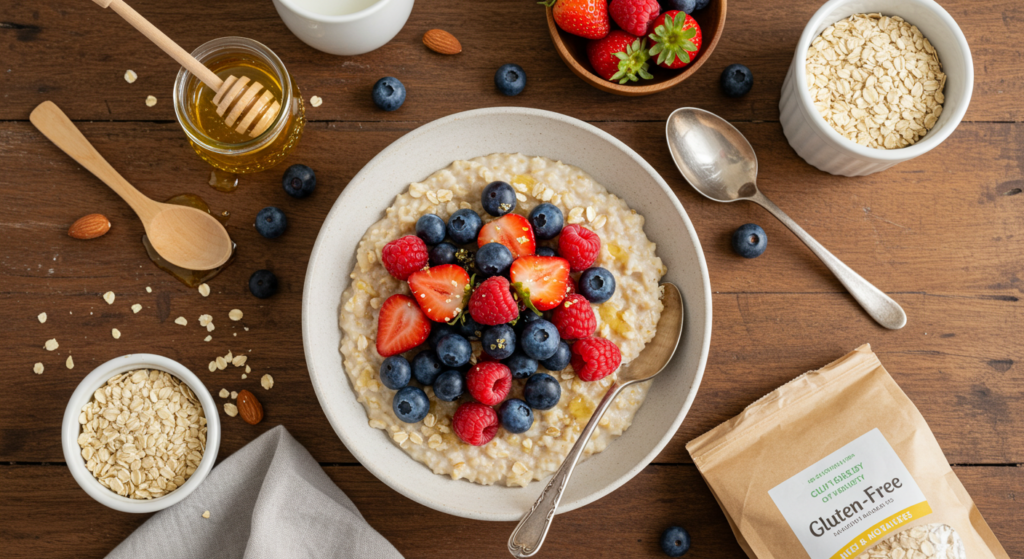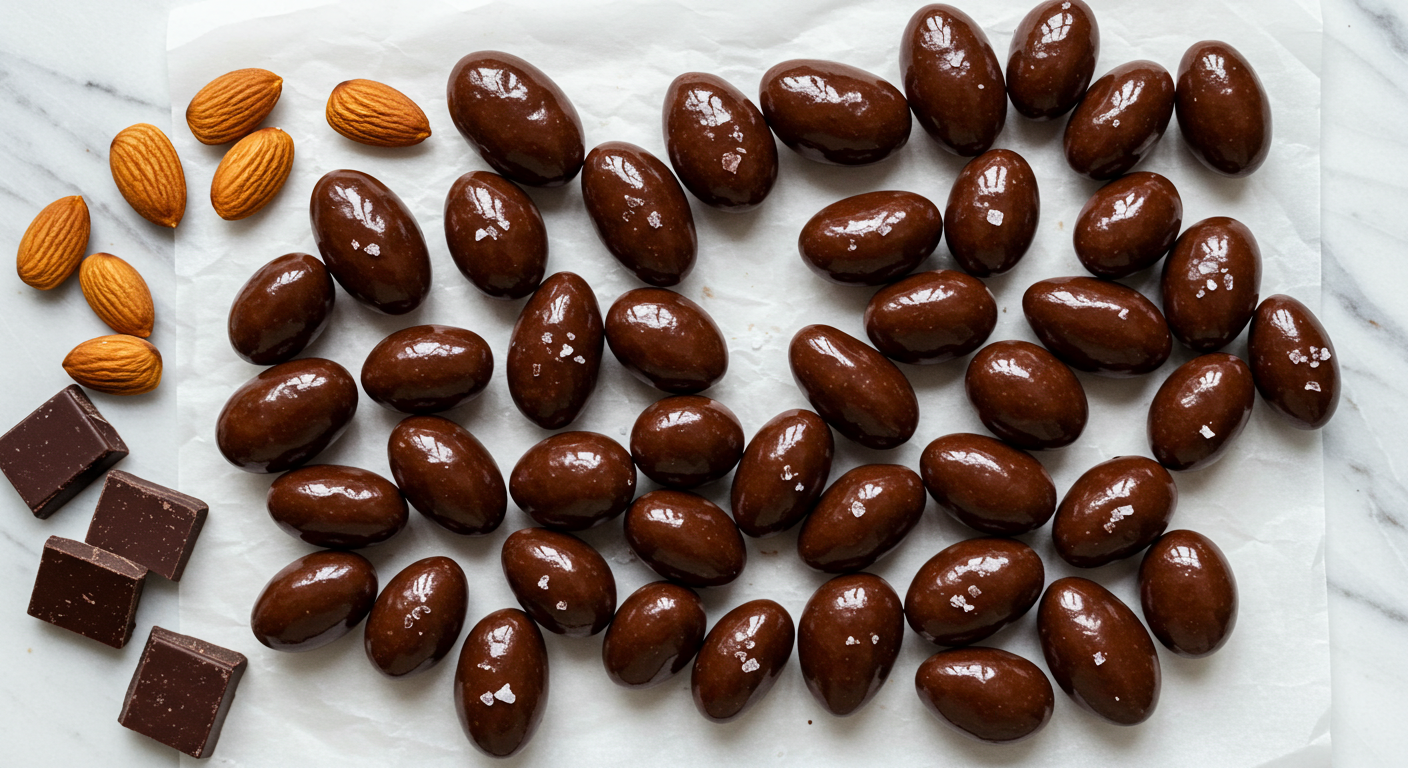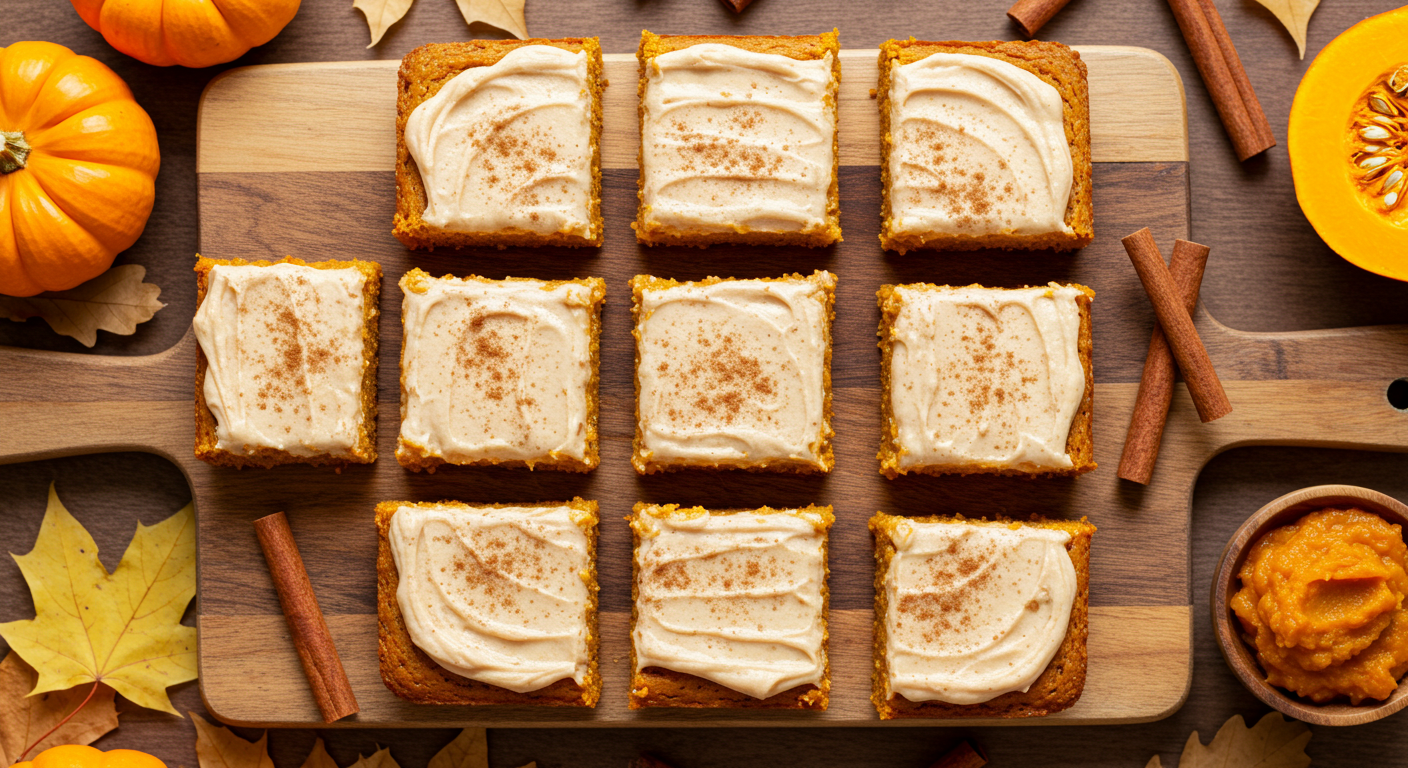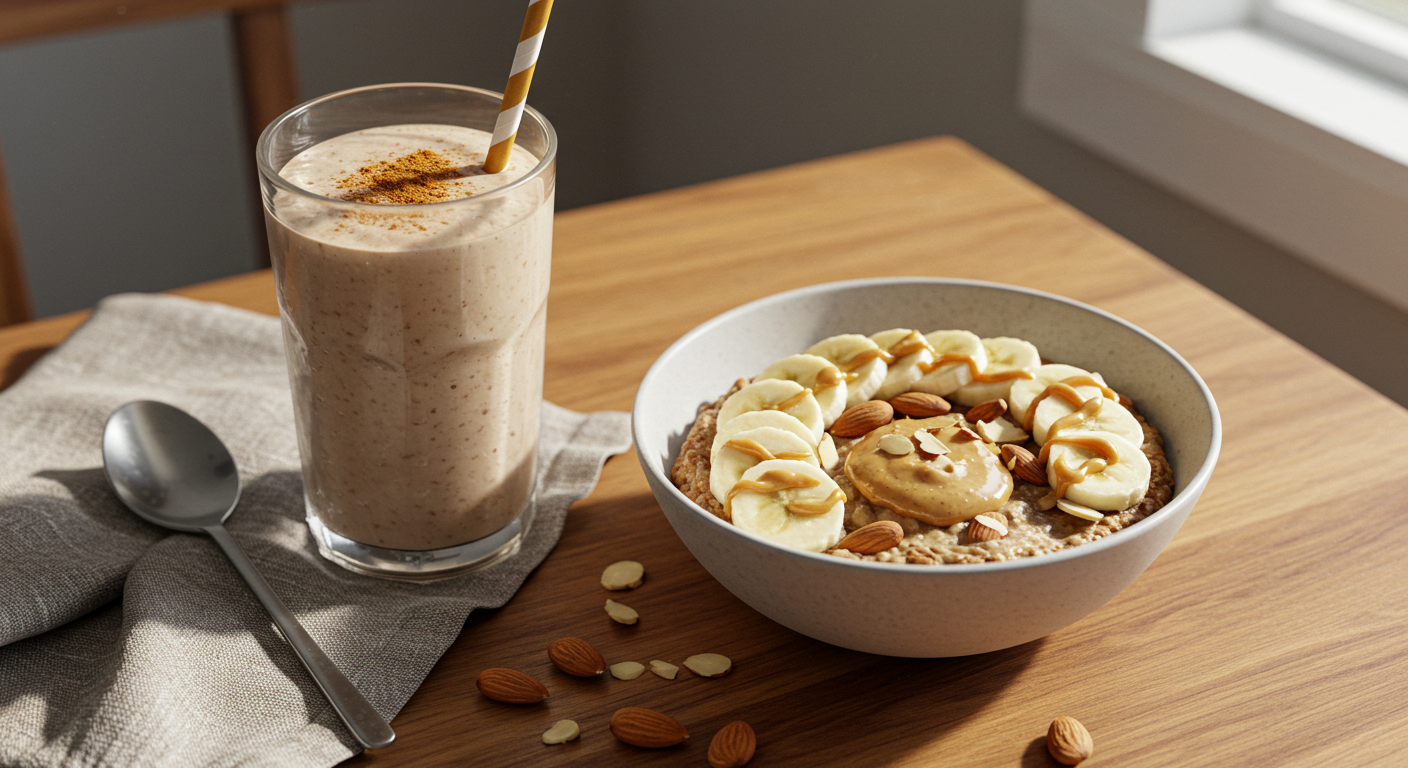Table of Contents
There’s something undeniably comforting about a warm bowl of oatmeal on a chilly morning. That creamy texture, those endless topping possibilities, and that stick-to-your-ribs satisfaction that keeps hunger at bay until lunchtime. But if you’re living gluten-free, you might be wondering: “Are oats actually safe for me to eat?” It’s a question I get asked all the time, and the answer isn’t as straightforward as you might think.
When I was first diagnosed with celiac disease, I sadly crossed oatmeal off my breakfast menu. What a mistake that was! Years later, I discovered that with the right knowledge and careful shopping, oatmeal could absolutely be back on my table. The key? Understanding which oats are truly gluten-free and which might be contaminated.
Did you know that while oats themselves don’t naturally contain gluten, most commercial varieties are processed in facilities that also handle wheat, barley, and rye? This cross-contamination is what makes many oats unsafe for those with celiac disease or gluten sensitivity.
Today, I’m sharing not only the crucial information about selecting truly safe oats but also six of my most trusted, family-favorite gluten-free oatmeal recipes. These have been tested countless times in my kitchen and have received enthusiastic thumbs-up even from my gluten-eating friends and family. Just like my popular Gluten-Free Veggie Burgers that readers can’t stop raving about, these oatmeal recipes prove that gluten-free eating can be both delicious and satisfying!
What is Gluten-Free Oatmeal?
Gluten-free oatmeal? Isn’t that just… regular oatmeal? Well, yes and no! Here’s where things get interesting (and a bit confusing). Pure oats are naturally gluten-free—surprise! So why do we need special “gluten-free” oats? It’s all about the journey those little oat groats take from farm to table.
Ever wonder why your grandma never worried about gluten in her oatmeal? Back in the day, oats were grown, harvested, and processed separately from gluten-containing grains. Modern efficiency changed all that! Today, most conventional oats share equipment, transportation, and processing facilities with wheat, barley, and rye—leading to cross-contamination that can make traditional oats unsafe for those with celiac disease or gluten sensitivity.
As they say, “the proof is in the pudding”—or in this case, the oatmeal! True gluten-free oatmeal comes from oats that are grown, harvested, and processed in dedicated gluten-free facilities. These certified gluten-free oats ensure your morning porridge won’t cause unwanted health issues. Ready to discover how these special oats can transform your breakfast routine?
Why You’ll Love These Gluten-Free Oatmeal Recipes
These gluten-free oatmeal recipes are absolute game-changers for anyone living with celiac disease or gluten sensitivity! The star quality of these recipes is their incredible versatility—each one can be customized to suit your taste preferences while still maintaining that perfect, creamy texture we all crave in a good bowl of oatmeal.
Making these gluten-free oatmeal dishes at home will save you significant money compared to pre-packaged gluten-free breakfast options. Have you seen the prices of those tiny gluten-free instant oatmeal packets lately? By purchasing certified gluten-free oats in bulk and preparing these recipes yourself, you’ll cut your breakfast budget dramatically while enjoying fresher, more nutritious results.
The flavor combinations in these recipes are truly exceptional. From warm cinnamon apple to decadent chocolate peanut butter, each recipe offers a unique taste profile that transforms humble oats into something special. The toppings and mix-ins create endless possibilities, making your morning bowl anything but boring. These recipes remind me of how versatile my Crispy Kale Chips recipe is—simple ingredients transformed into something extraordinary with the right preparation.
Ready to revolutionize your breakfast routine? Let’s dive into these delicious gluten-free oatmeal recipes that will have you looking forward to your morning meal!
How to Make Gluten-Free Oatmeal:
Quick Overview
Preparing gluten-free oatmeal is surprisingly simple, requiring minimal effort while delivering maximum satisfaction. What makes these recipes so appealing is how quickly they come together—most can be ready in under 10 minutes, making them perfect for busy mornings. The creamy texture combined with customizable mix-ins creates a breakfast that’s not only safe for those avoiding gluten but genuinely delicious for everyone. Most recipes take between 5-15 minutes to prepare, depending on whether you’re using quick oats, rolled oats, or steel-cut varieties.
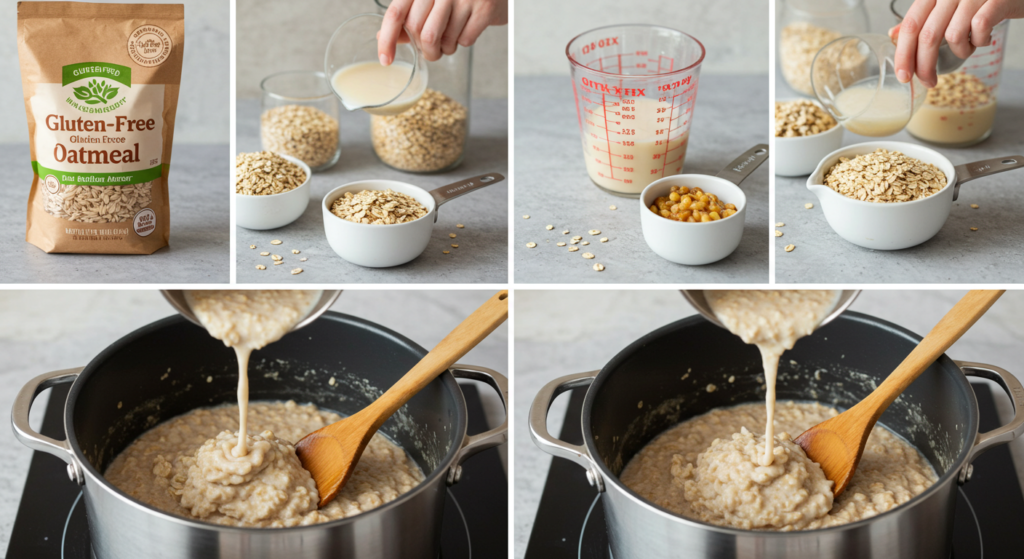
Key Ingredients for Gluten-Free Oatmeal:
- Certified gluten-free oats (quick, rolled, or steel-cut)
- Liquid of choice (water, milk, almond milk, etc.)
- Salt (just a pinch enhances flavor)
- Natural sweeteners (honey, maple syrup, or brown sugar)
- Fresh or dried fruits
- Nuts and seeds
- Spices (cinnamon, nutmeg, vanilla extract)
- Optional protein boosters (nut butter, protein powder)
Step-by-Step Instructions:
- Choose the right oats: Begin with certified gluten-free oats. Look for packaging that explicitly states “certified gluten-free” to ensure safety.
- Measure ingredients: For a single serving, use a 1:2 ratio of oats to liquid. Typically, ½ cup of dry oats to 1 cup of liquid works well for rolled oats. Quick oats may need slightly less liquid, while steel-cut oats require more (about 1:3 ratio) and longer cooking time.
- Combine oats and liquid: Place your oats in a medium saucepan and add your liquid of choice. Add a pinch of salt to enhance the flavor.
- Cook properly: For rolled oats, bring the mixture to a boil, then reduce heat to medium-low and simmer for 5-7 minutes, stirring occasionally. Quick oats will cook in 1-2 minutes, while steel-cut oats need 20-30 minutes of simmering.
- Check consistency: The oatmeal should be creamy but still have some texture. If it becomes too thick, add a splash more liquid. If too thin, cook a bit longer.
- Add flavorings and sweeteners: Remove from heat and stir in your choice of sweetener and spices. Vanilla extract, cinnamon, or nutmeg work beautifully.
- Add toppings: Transfer to a bowl and add your favorite toppings. Fresh or dried fruits, nuts, seeds, or a drizzle of honey all make excellent additions.
- Let it rest: Allow your oatmeal to sit for 1-2 minutes before eating. This helps it reach the perfect consistency and allows the flavors to meld together.
6 Trusted Gluten-Free Oatmeal Recipes
1. Classic Maple Cinnamon Oatmeal
Ingredients:
- 1 cup certified gluten-free rolled oats
- 2 cups water or milk of choice
- 1 teaspoon cinnamon
- 2 tablespoons pure maple syrup
- 1 teaspoon vanilla extract
- Pinch of salt
- Optional toppings: sliced banana, chopped nuts, extra maple syrup
Instructions:
- Combine oats, water/milk, and salt in a medium saucepan.
- Bring to a boil, then reduce heat to medium-low and simmer for 5-7 minutes, stirring occasionally.
- Remove from heat and stir in cinnamon, maple syrup, and vanilla extract.
- Transfer to bowls and add desired toppings.
2. Berry Protein Oatmeal Bowl
Ingredients:
- 1 cup certified gluten-free rolled oats
- 1½ cups milk of choice
- ½ cup water
- 1 scoop gluten-free vanilla protein powder
- 1 cup mixed berries (strawberries, blueberries, raspberries)
- 1 tablespoon chia seeds
- 1 tablespoon honey or maple syrup
- Pinch of salt
Instructions:
- Combine oats, milk, water, and salt in a saucepan.
- Cook over medium heat for 5-7 minutes, stirring occasionally.
- Remove from heat and stir in protein powder until completely combined.
- Fold in half of the berries, allowing them to slightly warm and release juices.
- Transfer to bowls and top with remaining berries, chia seeds, and a drizzle of honey.
3. Overnight Chocolate Peanut Butter Oats
Ingredients:
- 1 cup certified gluten-free rolled oats
- 1½ cups milk of choice
- 2 tablespoons natural peanut butter
- 1 tablespoon unsweetened cocoa powder
- 1 tablespoon maple syrup or honey
- ½ teaspoon vanilla extract
- Pinch of salt
- Optional toppings: banana slices, chocolate chips, additional peanut butter
Instructions:
- In a bowl or jar, combine oats, milk, peanut butter, cocoa powder, sweetener, vanilla, and salt.
- Mix thoroughly until all ingredients are well combined.
- Cover and refrigerate overnight or for at least 6 hours.
- In the morning, stir well and add a splash of milk if the oats are too thick.
- Add desired toppings and enjoy cold, or warm briefly in the microwave if preferred.
4. Apple Cinnamon Baked Oatmeal
Ingredients:
- 2 cups certified gluten-free rolled oats
- 1 teaspoon baking powder (gluten-free certified)
- 1½ teaspoons cinnamon
- ¼ teaspoon nutmeg
- ¼ teaspoon salt
- 2 cups milk of choice
- 1 large egg (or flax egg for vegan version)
- ¼ cup maple syrup
- 1 teaspoon vanilla extract
- 2 tablespoons melted coconut oil or butter
- 2 apples, diced (about 2 cups)
- ½ cup chopped walnuts or pecans
Instructions:
- Preheat oven to 350°F (175°C) and grease an 8×8-inch baking dish.
- In a large bowl, combine oats, baking powder, cinnamon, nutmeg, and salt.
- In another bowl, whisk together milk, egg, maple syrup, vanilla, and melted coconut oil.
- Add wet ingredients to dry ingredients and mix well.
- Fold in diced apples and half of the nuts.
- Pour mixture into the prepared baking dish and sprinkle with remaining nuts.
- Bake for 35-40 minutes until the top is golden and the oatmeal is set.
- Allow to cool for 5 minutes before serving. Can be enjoyed warm or cold.
5. Savory Breakfast Oatmeal Bowl
Ingredients:
- 1 cup certified gluten-free steel-cut oats
- 3 cups chicken or vegetable broth (gluten-free certified)
- 2 teaspoons olive oil
- 2 cloves garlic, minced
- ¼ cup chopped green onions
- Salt and pepper to taste
- Toppings: avocado slices, poached or fried egg, cherry tomatoes, microgreens, hot sauce
Instructions:
- Heat olive oil in a medium saucepan over medium heat.
- Add garlic and half of the green onions, sauté for 1 minute until fragrant.
- Add oats and toast for 1-2 minutes, stirring constantly.
- Pour in broth, bring to a boil, then reduce heat to low.
- Simmer for 25-30 minutes, stirring occasionally, until oats are tender and creamy.
- Season with salt and pepper to taste.
- Serve topped with avocado, egg, tomatoes, remaining green onions, and microgreens.
- Add hot sauce if desired.
6. Pumpkin Spice Oatmeal
Ingredients:
- 1 cup certified gluten-free rolled oats
- 2 cups milk of choice
- ⅓ cup pumpkin puree (not pumpkin pie filling)
- 2 tablespoons maple syrup or brown sugar
- 1 teaspoon pumpkin pie spice
- ½ teaspoon vanilla extract
- Pinch of salt
- Toppings: pepitas (pumpkin seeds), pecans, cream, extra maple syrup
Instructions:
- Combine oats, milk, and salt in a medium saucepan.
- Bring to a boil, then reduce heat to medium-low and simmer for 3-4 minutes.
- Stir in pumpkin puree, maple syrup, pumpkin pie spice, and vanilla.
- Continue cooking for 2-3 more minutes until thickened to desired consistency.
- Transfer to bowls and top with pepitas, pecans, a drizzle of cream, and extra maple syrup if desired.
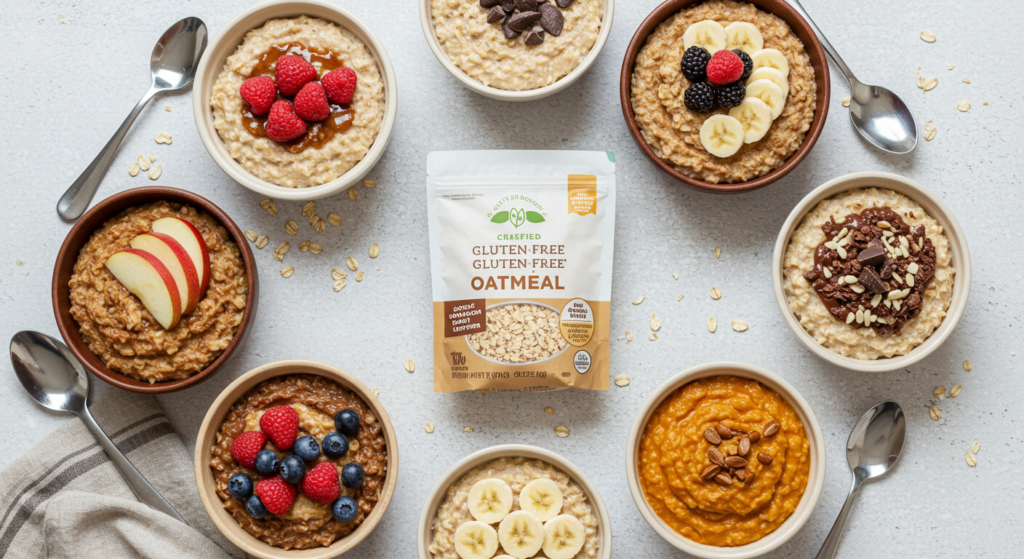
What to Serve Gluten-Free Oatmeal With:
Gluten-free oatmeal is incredibly versatile, pairing beautifully with numerous side dishes and beverages to create a complete breakfast experience. For a protein boost, consider serving your oatmeal alongside a couple of hard-boiled eggs or Greek yogurt with a drizzle of honey. The protein helps balance the carbohydrates in the oatmeal, providing sustained energy throughout the morning.
Fresh fruit is always a fantastic complement to oatmeal, either mixed in or served on the side. Try a colorful fruit salad with seasonal options like berries, melon, citrus, or stone fruits. The natural sweetness and acidity of fresh fruit provide a lovely contrast to the creamy oatmeal.
As for beverages, a warm mug of herbal tea makes a soothing partner to your breakfast bowl. Coffee lovers might enjoy how the roasted notes of coffee complement sweet oatmeal varieties. For a complete nutritional package, consider a small glass of freshly squeezed orange juice for vitamin C or a green smoothie to add extra vegetables to your morning routine.
Top Tips for Perfecting Gluten-Free Oatmeal:
Creating perfect gluten-free oatmeal every time involves more than just following a recipe. These expert tips will help you achieve the ideal texture and flavor:
- Toast your oats first: Before adding liquid, toast dry oats in a saucepan for 1-2 minutes. This enhances their nutty flavor and helps them maintain texture during cooking.
- Master the liquid ratio: Different oat varieties require different amounts of liquid. As a general rule, use a 1:2 ratio for rolled oats, 1:1.75 for quick oats, and 1:3 for steel-cut oats. Adjust according to your preferred consistency.
- Add salt: Don’t skip the pinch of salt! It enhances the flavor of oats without making them taste salty.
- Be careful with mix-ins timing: Add ingredients like fresh fruit, nut butter, or protein powder after cooking to prevent them from affecting the cooking process or breaking down too much.
- For creamier oatmeal: Use milk instead of water, or try a combination of both. Plant-based milks like almond or oat milk work wonderfully.
- Avoid common mistakes: Don’t rush the cooking process by using high heat, which can lead to boil-overs and unevenly cooked oats. Also, avoid constant stirring, which can break down the oats and create a gummy texture.
- Make a big batch: Prepare a large quantity and refrigerate portions for quick breakfasts throughout the week. Simply reheat with a splash of milk or water.
- For extra nutrition: Add ground flaxseed, hemp hearts, or chia seeds for omega-3 fatty acids and additional fiber.
Storing and Reheating Tips:
Proper storage and reheating are essential for maintaining the quality of your gluten-free oatmeal. Cooked oatmeal can be stored in an airtight container in the refrigerator for up to 4-5 days, making it perfect for meal prep. When storing, allow the oatmeal to cool completely before transferring it to the container to prevent condensation.
For freezing, portion cooked oatmeal into silicone muffin cups or freezer-safe containers. Frozen oatmeal will maintain its quality for up to 3 months. Label each portion with the date and any add-ins for easy identification.
When reheating refrigerated oatmeal, add a splash of milk or water to restore the creamy consistency, as oatmeal tends to thicken considerably when chilled. Microwave on medium power for 1-2 minutes, stirring halfway through. Alternatively, reheat on the stovetop over low heat, adding liquid as needed.
For frozen oatmeal, thaw overnight in the refrigerator or use the defrost setting on your microwave before reheating as directed above. Avoid using high heat when reheating, as it can create hot spots and dry out the oatmeal.
If you’re using overnight oats recipes, they’re best consumed within 2-3 days for optimal taste and texture. Give them a good stir before eating, as the liquid tends to settle at the bottom during storage.
Are All Oats Actually Safe for a Gluten-Free Diet?
This is perhaps the most important question for those following a gluten-free diet due to celiac disease or gluten sensitivity. The short answer is no—not all oats are safe for everyone on a gluten-free diet.
Pure oats are naturally gluten-free. However, most conventional oats on the market have been cross-contaminated with gluten-containing grains at some point in their production journey. This contamination typically occurs during growing, harvesting, transporting, or processing, when oats share equipment or facilities with wheat, barley, or rye.
For people with celiac disease or serious gluten sensitivity, this cross-contamination can be enough to trigger symptoms. Research has shown that conventional oats often contain enough gluten to cause problems for those with celiac disease—sometimes exceeding 20 parts per million (ppm), which is the threshold for gluten-free foods in many countries.
This is why certified gluten-free oats are essential. These oats are grown, harvested, transported, and processed in dedicated gluten-free facilities and undergo rigorous testing to ensure they contain less than 20 ppm of gluten. Look for clear “certified gluten-free” labeling and third-party certifications when purchasing oats.
It’s worth noting that a small percentage (approximately 5-10%) of people with celiac disease may also react to avenin, a protein in oats that’s similar to gluten. If you have celiac disease and are introducing oats to your diet for the first time, it’s advisable to start with small amounts and monitor your response, preferably under the guidance of a healthcare provider.
Conclusion: Enjoying Safe and Delicious Gluten-Free Oatmeal
Gluten-free oatmeal can be a nutritious, satisfying, and versatile addition to your diet when you understand how to select truly safe oats and prepare them deliciously. The six trusted recipes shared in this guide demonstrate just how varied and exciting gluten-free oatmeal can be—from comforting classics to innovative flavor combinations that might just become your new breakfast favorites.
Looking for more gluten-free meal ideas? Check out my popular Banza Pasta Nutrition guide to discover why this chickpea pasta is healthier than regular pasta!
Remember the key points we’ve covered: always choose certified gluten-free oats, experiment with different varieties (quick, rolled, or steel-cut) to find your preferred texture, and don’t be afraid to get creative with flavor combinations and toppings. With these principles in mind, you can enjoy the many benefits of oats without compromising your gluten-free lifestyle.
Whether you’re managing celiac disease, dealing with gluten sensitivity, or simply choosing to reduce gluten in your diet, these gluten-free oatmeal recipes prove that dietary restrictions don’t have to mean missing out on delicious, satisfying food. In fact, they might just inspire you to explore new breakfast possibilities you hadn’t considered before!
I’d love to hear about your favorite gluten-free oatmeal combinations in the comments below. Have you tried any of these recipes? Do you have your own trusted gluten-free oatmeal recipes to share? Let’s build a community of gluten-free oatmeal enthusiasts together!
For outdoor cooking enthusiasts, check out this handy Portable Butane Gas Stove – perfect for camping trips when you want to enjoy a warm bowl of gluten-free oatmeal in the great outdoors!
FAQ
Are oats naturally gluten-free?
Yes, pure oats are naturally gluten-free. However, most conventional oats are cross-contaminated with gluten during growing, harvesting, or processing because they often share equipment and facilities with wheat, barley, and rye. For those with celiac disease or gluten sensitivity, it’s essential to use certified gluten-free oats that are grown and processed in dedicated facilities.
What’s the difference between quick oats, rolled oats, and steel-cut oats?
All three are whole grain oats processed differently, affecting cooking time and texture. Steel-cut oats are the least processed, made by chopping whole oat groats into pieces, resulting in a chewy texture and 20-30 minute cooking time. Rolled oats (old-fashioned oats) are steamed and flattened, cooking in 5-7 minutes with a creamy yet somewhat textured result. Quick oats are pre-cooked, dried, and rolled thinner, cooking in just 1-2 minutes with a softer texture.
Can I make gluten-free oatmeal ahead of time?
Absolutely! Prepare a large batch and refrigerate portions for up to 5 days. Overnight oats recipes can be prepared in advance and refrigerated for 2-3 days. For longer storage, freeze individual portions of cooked oatmeal for up to 3 months. When reheating, add a splash of liquid to restore the creamy consistency.
How can I add more protein to my gluten-free oatmeal?
Boost the protein content by adding a scoop of gluten-free protein powder, a spoonful of nut butter, or mixing in Greek yogurt. You can also top your oatmeal with nuts, seeds, or serve it with eggs on the side. For plant-based options, hemp hearts, chia seeds, and flaxseeds all provide protein along with healthy fats.
Why do I need to look for certified gluten-free oats?
Certification ensures that oats contain less than 20 ppm of gluten, the standard for gluten-free foods in most countries. Certified gluten-free oats are grown, harvested, and processed in dedicated facilities to prevent cross-contamination. Without certification, conventional oats often contain enough gluten from cross-contamination to trigger symptoms in people with celiac disease or serious gluten sensitivity.
Is instant oatmeal gluten-free?
Not automatically. While plain instant oatmeal can be made from gluten-free oats, many commercial instant oatmeal packets contain additives or flavorings that may contain gluten. Additionally, if the instant oats aren’t certified gluten-free, they may be cross-contaminated. Always check for a certified gluten-free label on instant oatmeal products.
Can children with celiac disease eat gluten-free oatmeal?
Most children with celiac disease can safely consume certified gluten-free oats. However, it’s recommended to introduce them gradually under medical supervision, as a small percentage of people with celiac disease also react to avenin, a protein in oats. Consult with your child’s healthcare provider before introducing oats into their diet.
How can I make my gluten-free oatmeal more flavorful without adding sugar?
Enhance flavor with spices like cinnamon, nutmeg, cardamom, or vanilla extract. Fresh or dried fruits add natural sweetness. Try cooking oats in coconut milk for richness, or add unsweetened cocoa powder for chocolate flavor. Roasted nuts and seeds add crunch and nutty notes. For savory oatmeal, incorporate herbs, a soft-boiled egg, avocado, or a small amount of cheese.

